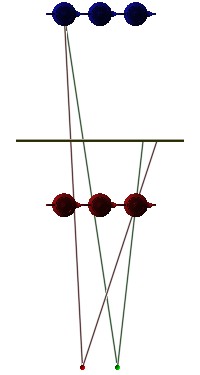Monocular Depth Cues
2. Motion Parallax
As you move your head from side to side, objects at various distances from the eye appear to move in different, but coherent ways. Our sensory system attributes these differences to differences in relative depth. For example, if you focus your eye on some object and move your head to the left, objects between your eye and the object on which you are focusing appear to move to the right, while objects farther away appear to move to the left along with your eye.
In the example here, all the teapots are the same size, but the blue ones are obviously much farther from the eye than are the red ones. In the first half of the movie, the eye is moving to the left; it then moves back to the right in the second half. Notice how the distant blue teapots track the eye movement while the nearer red teapots move in the opposite direction.

Simple geometry explains this phenomenon. Consider the adjacent image which illustrates the generation of two frames of this movie. We are "watching from above" as the movie is being made. That is, the camera capturing the image is placed at the red dot at the bottom and is focused on the teapots. The horizontal line between the two rows of teapots represents the projection plane onto which the teapots are projected. A picture is taken, and then the camera slides to the right to the position of the green dot. A second picture is taken.
The four lines (two each emanating from each eye position) illustrate how two of the teapots will project in the two frames. Specifically, we are studying the blue teapot on the far left in the top row, and the red teapot on the far right in the bottom row. Notice that as the eye moves to the right, it is clear the projection of the red teapot (the one closer to our eye) will move to the left; by contrast, the blue teapot (the one farther from the eye) moves to the right along with the eye.
Now suppose two successive images from this movie were to be displayed at once, one visible to just the left eye, and one visible to just the right. While there would be no motion, the difference between these two images creates the "stereo effect" we have set out to study in these notes. More specifically, this single-image effect is referred to as retinal disparity, one of the binocular cues that we will examine shortly.

